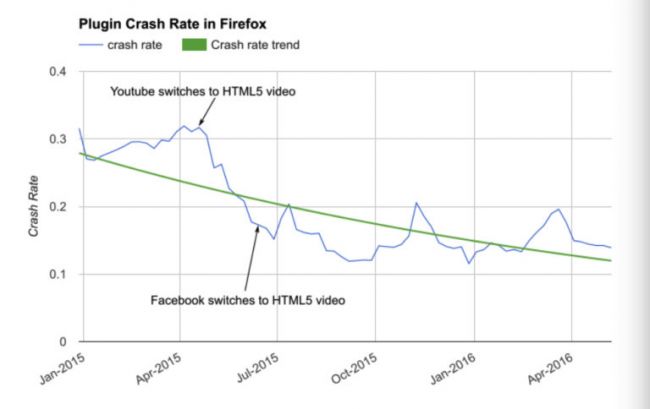Google Chrome Set to End Support for Adobe Flash
In the early days of Web 2.0, Flash used to power much of the rich content like videos, games, or even interactive navigation. However, it has now been defeated by more capable technologies and fallen significantly out of favor in recent years. Finally, Google announced that it will "de-emphasize" Adobe Flash in its Chrome browser in favor of HTML5 in December when Chrome 55 rolls out.
 Do you remember the time when Apple decided not to support Flash on the iPhone and iPad, yet its legendary CEO Steve Jobs even took to his keyboard to write a 1,700 word essay on Flash and why he would not allow the multimedia player on his devices – citing six reasons below which are the very same reasons Google is now ditching Flash:
Do you remember the time when Apple decided not to support Flash on the iPhone and iPad, yet its legendary CEO Steve Jobs even took to his keyboard to write a 1,700 word essay on Flash and why he would not allow the multimedia player on his devices – citing six reasons below which are the very same reasons Google is now ditching Flash:
Adobe Flash is proprietary.
Newer video formats are superior and widely available.
Flash is insecure and does not perform well.
Flash kills battery life.
Flash does not support touch.
Apple did not want developers writing Flash apps instead of iPhone apps.
The first significant change to Flash on Chrome will materialize in September with Chrome 53 when Google plans to block all page analytics that run with Flash. Instead of seeing a visual element, Flash-based analytics happen entirely “behind-the-scenes” and load in the background. Even so, it’s still Flash usage as far as your computer’s concerned. Once Chrome starts blocking background-loading Flash, Google claims it will save users more battery life, as well as bring faster page loads and improve site responsiveness.
Finally, in December, Google will finish what Steve Jobs started six years ago, and Adobe Flash will no longer be turned on by default in Chrome, which is used by 50% of people on desktop, according to estimates. Instead, Chrome will use HTML5 by default, a more modern standard that can provide better battery life, reliability, and security. If a website only works with Flash, then people will be prompted to enable the plugin on their first visit.
Security is and has been a major concern about the software, since it has regularly come under siege and is frequently targeted by hackers who take advantage of flaws in the software to infect users’ systems. That’s why security experts have been calling for its retirement for the past several years, as having Flash enabled more of a security risk than a benefit. After all, most of the web now runs on HTML5.
For years, Google has proclaimed that Flash is an antiquated format that must become extinct, and has been rapidly phasing Flash out of its services. Last September, it started blocking Flash ads on Chrome, and in June it stopped accepting Flash-based advertising across the board.
Do We Really Need Adobe Flash?
Security Analyst and Blogger Graham Cluley says no: “The problem is that perhaps Adobe doesn’t feel happy acknowledging that securing Flash is beyond them, and so is unwilling to drop the product. The truth is that the company would probably gain a lot more respect from the internet community if it worked towards this ultimate fix for the Flash problem, rather than clinging on to the belief that it might be able to one day make Flash secure. As it is, the only people who truly seem to love Adobe Flash these days are the criminals themselves,” he wrote in his blog post.
That assessment is backed up by Investigative Cybercrime Reporter Brian Krebs as he ran a bit of an experiment. After trying to go a month without using the Adobe software, he said: “So, rather than continue the patch madness and keep this insecure software installed, I decided to the pull the…er…plugin.” During his experiment, he only needed it two times, when he encountered a site hosting the instructional video for a home gym and a live-streamed legislative hearing.
Moreover, Chromium developers plan to exempt the top 10 domains that use Flash for one year in order to reduce the impact of the blockade:
"While Flash historically has been critical for rich media on the web, today in many cases HTML5 provides a more integrated media experience with faster load times and lower power consumption," the Chromium developers explain. This change reflects the maturity of HTML5 and its ability to deliver an excellent user experience. We will continue to work closely with Adobe and other browser vendors to keep moving the web platform forward, in particular paying close attention to web gaming."
The Phase Out Flash Party
Google is not alone. Apple is adopting a similar strategy with Safari 10, launching it alongside macOS Sierra. The upcoming version of Safari will prefer HTML5, and no longer tell sites that the plugins are installed, said Safari developer Ricky Mondello in a post on the official WebKit blog. The browser has no built-in exception list, and so people will have to enable plugins on a per-site basis. If a site element is requesting Flash, it will initially claim that the plugin isn't installed and display an Adobe download link. In Safari 10, clicking on this link will let users know that the plugin actually is on their system, and ask whether they want to activate it once, every time they visit, or cancel.
Mozilla has recently joined the phase out Flash party as well, announcing its plans to gradually disengage its Firefox web browser with Adobe’s multimedia player. In August, Firefox will no longer support “certain Flash content” that it considers “not essential to the user experience,” although Mozilla did not specify what type of Flash content it was referring to.

Even the creator of Flash, Adobe, has recognized the issue by detaching itself from the Flash brand and rebranded its animation software from Adobe Flash Professional to Adobe Animate CC, saying it did so to signify that two-thirds of all content created using the software is in the HTML5 format, rather than Flash.
Many websites, including Facebook, Vimeo, Netflix, The Washington Post, and the U.S. government, are shifting now to secure their traffic with encryption through the adoption of HTTPS, which protects users from hackers.
Adobe responded to the move from Flash to HTML5 by noting that it believes HTML5 is the web platform of the future:
"We work closely with Mozilla, Microsoft, Facebook and others to facilitate the adoption of these open standards," Adobe said in a statement. "Google's decision is part of this industry wide evolution that Adobe is heavily invested in."
Neither Google nor Mozilla are cutting ties with Adobe and hanging Adobe completely out to dry. Mozilla said it would “continue to work closely with Adobe to deliver the best possible Flash experience for our users” as it phases the multimedia player out, and said that an engineering partnership between the two companies has improved some performance and stability in Firefox when it displays Flash content. While Anthony LaForge, Curator of Flash in Chrome wrote: "Flash helped make the Web a rich, dynamic experience, and shaped the modern set of web standards," LaForge wrote. "We continue to work closely with Adobe to ensure that your web experience is as fast and secure as possible and to help the Web transition to HTML5."
Though it was once critical for rich media, Flash has become a security liability. In April, researchers discovered a security hole that allowed attackers to inject ransomware which encrypts data, locking up computers, then demands payments that often range from $200 to $600 to unlock each infected PC. It seems like a good time for Adobe to arrange a date on the chopping block for Flash.

Venus Tamturk
Venus is the Media Reporter for CMS-Connected, with one of her tasks to write thorough articles by creating the most up-to-date and engaging content using B2B digital marketing. She enjoys increasing brand equity and conversion through the strategic use of social media channels and integrated media marketing plans.